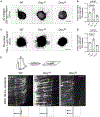A tug of war between DCC and ROBO1 signaling during commissural axon guidance
- PMID: 37149867
- PMCID: PMC10335249
- DOI: 10.1016/j.celrep.2023.112455
A tug of war between DCC and ROBO1 signaling during commissural axon guidance
Abstract
Dynamic and coordinated axonal responses to changing environments are critical for establishing neural connections. As commissural axons migrate across the CNS midline, they are suggested to switch from being attracted to being repelled in order to approach and to subsequently leave the midline. A molecular mechanism that is hypothesized to underlie this switch in axonal responses is the silencing of Netrin1/Deleted in Colorectal Carcinoma (DCC)-mediated attraction by the repulsive SLIT/ROBO1 signaling. Using in vivo approaches including CRISPR-Cas9-engineered mouse models of distinct Dcc splice isoforms, we show here that commissural axons maintain responsiveness to both Netrin and SLIT during midline crossing, although likely at quantitatively different levels. In addition, full-length DCC in collaboration with ROBO3 can antagonize ROBO1 repulsion in vivo. We propose that commissural axons integrate and balance the opposing DCC and Roundabout (ROBO) signaling to ensure proper guidance decisions during midline entry and exit.
Keywords: CP: Developmental biology; CP: Neuroscience; Netrin1/DCC; SLIT/ROBO; alternative splicing; axon guidance; midline switch; silencing model.
Copyright © 2023 The Authors. Published by Elsevier Inc. All rights reserved.
Conflict of interest statement
Declaration of interests The authors declare no competing interests.
Figures







References
-
- Serafini T, Kennedy TE, Galko MJ, Mirzayan C, Jessell TM, and Tessier-Lavigne M (1994). The netrins define a family of axon outgrowth-promoting proteins homologous to C. elegans UNC-6. Cell 78, 409–424. - PubMed
-
- Brose K, Bland KS, Wang KH, Arnott D, Henzel W, Goodman CS, Tessier-Lavigne M, and Kidd T (1999). Slit proteins bind Robo receptors and have an evolutionarily conserved role in repulsive axon guidance. Cell 96, 795–806. - PubMed
-
- Butler SJ, and Dodd J (2003). A role for BMP heterodimers in roof plate-mediated repulsion of commissural axons. Neuron 38, 389–401. - PubMed
-
- Augsburger A, Schuchardt A, Hoskins S, Dodd J, and Butler S (1999). BMPs as mediators of roof plate repulsion of commissural neurons. Neuron 24, 127–141. - PubMed
-
- Charron F, Stein E, Jeong J, McMahon AP, and Tessier-Lavigne M (2003). The morphogen sonic hedgehog is an axonal chemoattractant that collaborates with netrin-1 in midline axon guidance. Cell 113, 11–23. - PubMed
Publication types
MeSH terms
Substances
Grants and funding
LinkOut - more resources
Full Text Sources
Molecular Biology Databases
Research Materials
Miscellaneous

